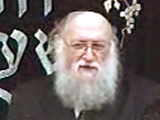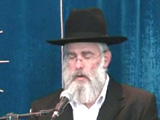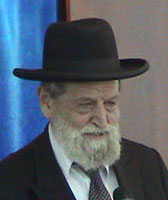Beit Midrash
- Sections
- Chemdat Yamim
- Bemare Habazak - Rabbis Questions
Answer: Most of the halachot of tziruf (joining together) for a minyaninvolve people in adjoining rooms or courtyards or some people being inside and some outside. There the main factor is whether they are in the same domain (see Shulchan Aruch, Orach Chayim 55:13, ibid. 18), although other factors can cause tziruf (see ibid. 14, 15).
Regarding the tziruf for zimun in Birkat Hamazon, visual contact between the people connects them even if they are in different domains (Shulchan Aruch, OC 195:1). A major question is whether visual contact combines people for the apparently stricter matter of a minyan for tefilla, as well. The Rashba (Shut I:96) was asked why a chazan standing on abima that is a halachically separate domain joins up with the others. He gives two answers: 1. A bima is made to serve as an integral part of theshul; 2. If some people in one domain see people in the other one, they constitute one unit. The Shulchan Aruch (OC 55:19) cites only the Rashba’s first answer as halacha regarding tziruf for a minyan. There is a major machloket among Acharonim whether one can also rely upon visual contact for tefilla (see Sha’arei Teshuva 55:15). The Mishna Berura (55:48, 52) cites both opinions and seems to prefer the lenient one. The Kaf Hachayim (ad loc. 70) accepts the stringent opinion.
What should be the determining factor when all the people are outside? Mishneh Sachir (I:12) and Minchat Yitzchak (II:44) say that if they can see and hear each other, this creates tziruf. These conditions were fulfilled in your case. However, you likely failed another condition. The Shulchan Aruch (OC 195:1) cites an opinion that a public path that separates between the parts of the group prevents tziruf for zimun, even if they see each other and/or are served by a common waiter (Mishna Berura 195:8). The Taz (195:2) says that even a minor private path separates. (See Teshuvot V’hanhagot I:163 for an extremely strict approach on what is considered a path, but even assuming we reject it, it is unclear what the cut-off point is). You do not describe, other than the insignificant low wall, what was in between your group and thekohen, but it is likely that within 50 meters in a cemetery there are pathways, and the Mishneh Sachir and Minchat Yitzchak say this prevents tziruf.
We can suggest that if the cemetery is fenced in, internal minor paths do not separate people. There is also logic to accept lenient opinions in our context. For one, it is emotionally important for people to be able to say Kaddish for their loved ones. Secondly, a possibly unauthorized Kaddish is not comparable to a possibly unauthorizedberacha (l’vatala). A beracha l’vatala includes saying Hashem’s name improperly, which is either a Torah-level or at least a serious Rabbinic violation (see Tosafot, Rosh Hashana 33a). In contrast, we find poskimwho say that one can be lenient in questionable cases of Kaddish (see Mahrashag II:40, regarding leniency to count a child as a tenth person for a minyan for Kaddish.)
The fact that the kohen was forbidden to come to where the majority of you were standing is not an issue. First, we are unaware of a source that a problem exists in this context. We do find a parallel application of your logic. If three people eat together in a manner that each may not, for halachic reasons, eat from the other’s food, there is no tziruf forzimun (Shulchan Aruch, OC 196:3). However, it is enough that Reuven can eat from Shimon’s food, even if Shimon cannot eat from Reuven’s. In your case, you could have gone to where the kohen is. Actually, you probably should have gone to where the kohen was, as Kaddish does not have to be said right next to the grave of the deceased you want credited.

Bemare Habazak - Rabbis Questions (628)
Rabbi Daniel Mann
219 - Returning a Loan Complicated by Currency Changes
220 - Kohen and Others Joining for a Minyan “In” a Cemetery
221 - Tricking a Cheater
Load More

Ask the Rabbi: Yissachar and Zevulun for Mitzvot
Rabbi Daniel Mann | Tammuz 5785

Ask the Rabbi: Wearing a Kippa in Today’s US Social Atmosphere
Rabbi Daniel Mann | Tammuz 5785

Ask the Rabbi: Beracha Acharona on Cake
Rabbi Daniel Mann | Tevet 5786

Ask the Rabbi: Not Taking Vacation Time on Chol Hamo’ed
Rabbi Daniel Mann | Nisan 5785

Rabbi Daniel Mann

Yitro Question
5772

Washing Hands with Soap on Yom Kippur
Tishrei 4 5776

Giving an Envelope on Shabbat to Use for Donations
5773





















